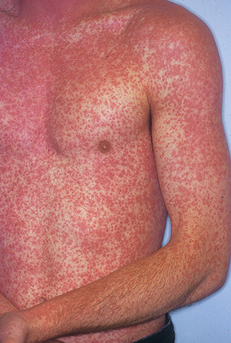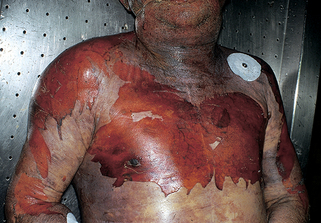Chapter 14 Drug eruptions
1. A patient presents to your office with a 10-page typed out medical history. She states that she is “allergic” to twenty different medicines. Is she likely to have drug allergies or drug intolerances to most of these drugs?
Drug intolerance. Drug intolerances account for 90% of adverse drug reactions. An adverse reaction to a drug is an undesirable and usually unanticipated response independent of the intended therapeutic purpose of the medication. An adverse drug reaction may be either immunologic (i.e., drug allergy) or nonimmunologic (i.e., drug intolerance).
2. Name some nonimmunologic drug reactions.
• Nonimmunologic activation of effector pathways, such as direct release of histamine from mast cells and basophils by aspirin, nonsteroidal antiinflammatory drugs (NSAIDs), opiates, polymyxin B, d-tubocurarine, and radiocontrast media
• Cumulative toxicity, such as the accumulation of drugs or metabolites in the skin (e.g., argyria with the use of silver nitrate spray)
• Normal pharmacologic effects of the drug that are not the primary therapeutic objective (e.g., alopecia following chemotherapy)
• Drug interactions (e.g., administration of ketoconazole may lead to higher levels of cyclosporine and increased toxicity)
• Metabolic changes, such as warfarin producing a hypercoagulable state that results in warfarin necrosis
• Exacerbation of preexisting dermatologic diseases (e.g., lithium can exacerbate acne, psoriasis, and subcorneal pustular dermatosis)
• Ecologic changes, such as antibiotics that reduce the bacteriologic flora, predisposing the patient to candidal infections
• Inherited enzyme or protein deficiencies (e.g., the phenytoin hypersensitivity syndrome occurs in patients deficient in epoxide hydrolase, an enzyme required for metabolism of a toxic epoxide derived from phenytoin)
3. What is the most common manifestation of an adverse drug reaction?
Cutaneous reactions are the most common adverse drug reaction and produce a wide range of manifestations: pruritus, maculopapular eruptions, urticaria, angioedema, phototoxic and photoallergic reactions, fixed drug reactions, erythema multiforme, vesiculobullous reactions, and exfoliative dermatitis. Drug-attributed skin reactions are seen in 2% to 5% of inpatients and >1% of outpatients.
4. How does a cutaneous drug eruption typically present?
• Stevens-Johnson syndrome: 4%
Key Points: Drug Eruptions
1. Consider a fixed drug eruption in a patient who presents with bullous or hyperpigmented lesions that are recurrent at the same site.
2. Consider a drug reaction in any patient who presents with an abrupt-onset, symmetrical, cutaneous reaction.
3. Consider a photoinduced drug reaction in a patient presenting with an erythematous, cutaneous reaction involving sun-exposed areas.
5. How should a suspected drug reaction be evaluated?
7. Can preexisting diseases enhance the chance of getting a maculopapular skin eruption when using amoxicillin or ampicillin?
Amoxicillin or ampicillin produces a maculopapular eruption in about 5% of patients taking these drugs (Fig. 14-1). In patients with infectious mononucleosis, the risk of developing a maculopapular eruption increases to 69% to 100%. In chronic lymphocytic leukemia, the incidence is 60% to 70%. Some studies report that maculopapular eruptions are more common in patients who are also taking allopurinol, but this is not accepted by all authorities. The pathogenesis for this phenomenon is unknown.
8. What infectious disease increases the chance of a cutaneous adverse reaction to trimethoprim-sulfamethoxazole?
9. Which feared drug eruption results in sloughing of the entire skin surface and mucous membranes?
Toxic epidermal necrolysis (TEN) is one of the most severe cutaneous drug eruptions. The skin is initially erythematous and tender but quickly sloughs off in large sheets like “wet wallpaper” (Fig. 14-2). The condition can progress very rapidly, with one of seven patients losing their entire epidermis in 24 hours. Without an epidermis, the body has difficulty keeping fluids in and bacteria out. Despite aggressive supportive care, the mortality rate ranges from 11% to 35%, with the majority of deaths being attributed to sepsis.
Table 14-1. Drugs Most Likely to Produce a Cutaneous Reaction
| DRUG | REACTIONS PER 1000 PATIENTS |
|---|---|
| Amoxicillin | 51.4 |
| Trimethoprim-sulfamethoxazole | 47 |
| Ampicillin | 42 |
| Ipodate sodium | 27.8 |
| Whole blood | 28 |
| Cephalosporins | 13 |
Stay updated, free articles. Join our Telegram channel

Full access? Get Clinical Tree










